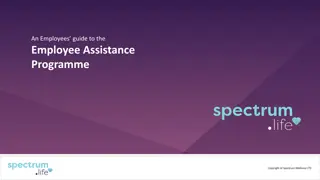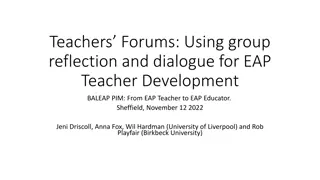Engaging Online Students Effectively: Strategies for Camera-Off Settings
Exploring the challenges and strategies for engaging online students when cameras are off, this presentation outlines the rationale, methodology, findings, discussions, conclusions, and limitations related to this topic. The content delves into the novelty of the online teaching environment, factors affecting camera use, prior literature on student engagement, and research gaps in fully online courses.
Download Presentation

Please find below an Image/Link to download the presentation.
The content on the website is provided AS IS for your information and personal use only. It may not be sold, licensed, or shared on other websites without obtaining consent from the author. Download presentation by click this link. If you encounter any issues during the download, it is possible that the publisher has removed the file from their server.
E N D
Presentation Transcript
Checking understanding and engaging online students when cameras are off. caitlin.coyle@glasgow.ac.uk
Presentation Outline Rationale Methodology Findings (& Discussion) Conclusions Limitations References
Rationale Novelty of the teaching and learning environment Mass move to online teaching from March 2020 on account of the Covid-19 pandemic Teachers and learners may have been new to online environment e.g. using online platforms and digital tools Teachers new to examining and assessing online Many perhaps unfamiliar with other privacy issues associated with online teaching
Rationale Discussion/Debate Anecdotal from various conferences FE and HE webinars attended in 2020 BALEAP Jiscmail in June-July 2020
Rationale Factors beyond control making camera use difficult/undesirable Privacy Wifi bandwidth issues Having access to a webcam
Rationale Prior literature Dixson(2015) observational learning behaviors (i.e., reading e-mails, reading discussion posts, viewing content lectures and documents) and application learning behaviors (posting to forums, writing e- mails, taking quizzes) Application learning had a stronger correlation with self- reported engagement than observational Discussion board activity related to active learning and social constructivist theories
Rationale Prior literature Kahn, Everington, Kelm, Reid and Watkins (2017) Evidence of positive correlation use of learning technology and student engagement from the National Survey of Student Engagement (US survey) Participation in HE now seen by many effectively obligatory , relationship with motivation Reflexivity and motivation in discussion board activity
Rationale Research Gaps Courses fully online (both synchronous and asynchronous) Novelty of this to both teachers and learners
What can I do? Accept that students cannot or do not want their cameras on Discover or rediscover different ways of checking understanding and engaging students
Methodology Anonymous Microsoft Forms questionnaire with 7 questions Teachers in FE and HE (University of Glasgow s Scholarship and Learning Team; University of Glasgow s Short Course Tutors Moodle Forum; Glasgow International College Team; the ESOL Research Jiscmail and the University of Sheffield s Oct 2020-Dec 2020 Learning Technologies in EAP cohort) 44 responses (EAP, ESP, General English, Medicine, Public Health, Maths and Functional Skills, Italian, Portuguese, Translating, History, Economics)
Findings 82 % some, most, every class 61% most, every class
Findings: checking understanding Q3. Do you use any digital apps or online tools to check students understanding of lesson content when students have their cameras off in your online class? 57%mentioned use of in-built tech tools in the teaching software they were using e.g. Zoom: Chat-box, screen-share, whiteboard, polls, break-out rooms, emojis Microsoft Office 365 (MS Teams): Chat-box, OneNote, posts, Microsoft Forms and Teams Assignments Google Classroom: Chat-box, Google Docs, Google Forms, Jamboard, break-out rooms BBB: Chat-box, posts, polls and break-out rooms
Findings: checking understanding Q3. Do you use any digital apps or online tools to check students understanding of lesson content when students have their cameras off in your online class? 36% mentioned using other digital tools/apps Mentimeter, Padlet, Kahoot, Socrative, Quizlet & Slido, Moodle Wikis, Whatsapp
Findings: checking understanding Q5. Do you use any other techniques to check understanding of lesson contentwhen students have their cameras off in your online class 57% mentioned some sort of Q&A: CCQs, ICQs 39% mentioned nomination Flipped Learning was also mentioned as a way of students coming ready to class with questions and discussion points
Overall results: Checking understanding 57% use in-built tech tools to check understanding, including chat-boxes, polls and break-out rooms 36% use other digital tools including: Padlet, Mentimeter and Kahoot 57% mentioned some sort of Q&A: CCQs, ICQs 39% nomination
Findings: engaging students Q4. Do you use any digital apps or online tools to engage students in lesson content when they have their cameras off in your online class? 48%reported using in-built tech tools 52%reported using other tech tools Padlet was the most common. Wordwall was mentioned for the first time. Using music was also mentioned. VLEs (Moodle and Canvas ) were mentioned.
Findings: engaging students Q6. Do you use any other techniques to engage students in lesson content when they have their cameras off in your online class 7% mentioned flipping learning/ pre-lesson warm- up task Others mentioned: short section of general chatting; being encouraging and reassuring, and the use of visual aids One participant mentioned engaging at the beginning of the lesson is particularly important
Overall findings: engaging students 48% in-built tech tools 52% other digital tools 7% flipping the lesson content
Conclusions In-built tech tools used more (57%) to check understanding than engagement (48%) Other digital tools such as Padlet and Mentimeter are used more to engage (52%) than check understanding (36%) Traditional teaching mechanisms of checking understanding can and are still being used Newer teaching approaches such as flipped learning may be useful for both to check understanding and to increase engagement
Limitations Ignoring the reasons why the cameras are turned off the reasons why may affect motivation and engagement It may have be better to focus on one sector/one subject: teachers have students with different needs, access to technology A more in-depth analysis of the difference between sectors/subjects A more thorough piloting of the questions
References Dixson, M. D. (2015). Measuring student engagement in the online course: The online student engagement scale (OSE). Online Learning (Newburyport, Mass.), 19(4) doi:10.24059/olj.v19i4.561 Kahn, P., Everington, L., Kelm, K., Reid, I., & Watkins, F. (2017). Understanding student engagement in online learning environments: The role of reflexivity. Educational Technology Research and Development, 65(1), 203-218. doi:10.1007/s11423-016-9484-z
Thanks again to: University of Glasgow s Scholarship and Learning Team s participants University of Glasgow s Short Course tutors Glasgow International College tutors The ESOL Research Jiscmail participants The University of Sheffield s Oct 2020-Dec 2020 Learning Technologies in EAP course partcipicants
Thank you for listening If you have any questions, I would be more than happy to try to answer them























